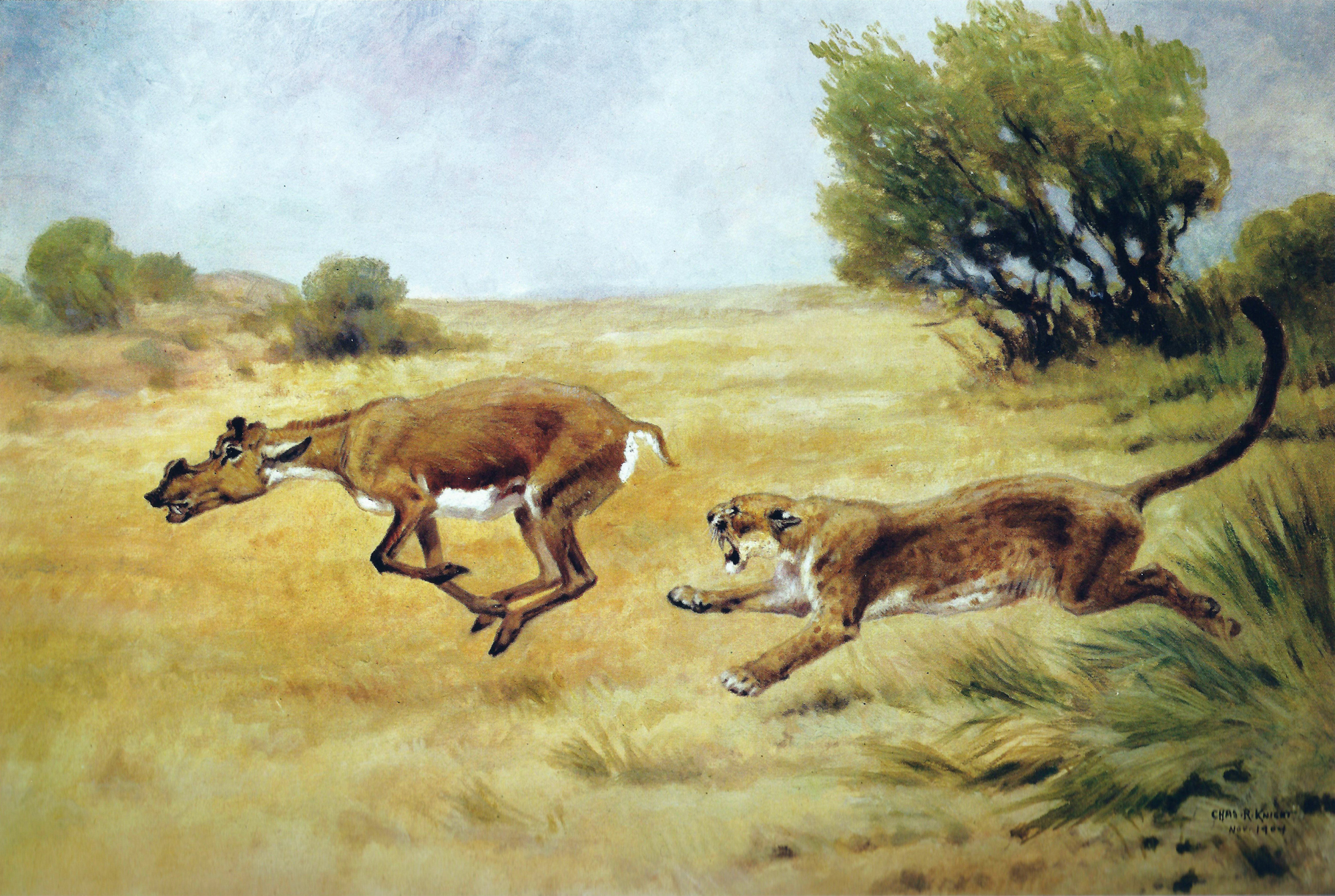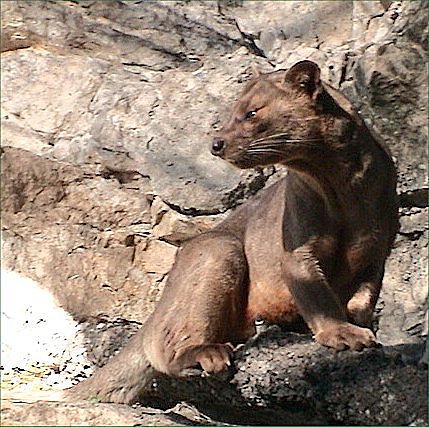|
Barbourofelidae
Barbourofelidae is an extinct family of carnivorans of the suborder Feliformia, sometimes known as false saber-toothed cats, that lived in North America, Eurasia and Africa during the Miocene epoch (16.9—9.0 million years ago) and existed for about . Taxonomy The type genus, ''Barbourofelis'', was originally described by Schultz et al. (1970) and assigned to a new tribe, Barbourofelini, within the felid subfamily Machairodontinae, along with the other sabre-toothed cats. Subsequently, the tribe was reassigned to the Nimravidae by Tedford (1978) and raised to a subfamily by Bryant (1991). However, a number of studies in the early 2000s identified a closer affinity of the barbourofelines to the Felidae than to the Nimravidae and they were reranked as a distinct family by Morlo et al. (2004). Since then the prevailing view has the barbourofelids as the sister group to the Felidae, although this has recently been challenged, following the description of the middle Miocene genus ... [...More Info...] [...Related Items...] OR: [Wikipedia] [Google] [Baidu] |
Prosansanosmilus Peregrinus
''Prosansanosmilus'' is an extinct genus of mammalian carnivores of the suborder Feliformia, family Barbourofelidae, which lived in Europe during the Miocene epoch (16.9—16.0 mya), existing for approximately . It contains ''Prosansanosmilus peregrinus'', which died out in the Miocene epoch. Taxonomy ''Prosansanosmilus'' was named by Heizmann et al. (1980). Its type is ''Prosansanosmilus peregrinus''. It was assigned to Nimravinae by Heizmann et al. (1980); to Felidae by Carroll (1988); to Barbourofelinae by Bryant (1991); and to Barbourofelidae by Morlo et al. (2004) and Morlo (2006). A new species, ''P. eggeri'' from the Middle Eocene locality of Sandelzhausen, Germany, was described in 2004. It differed from other European barbourofelids in having a more plesiomorphic ("ancestral") morphology, with less developed sabretooth adaptations and being smaller. However, the species is stratigraphically younger than ''P. peregrinus''; and probably part of the African faunal immig ... [...More Info...] [...Related Items...] OR: [Wikipedia] [Google] [Baidu] |
Ginsburgsmilus
''Ginsburgsmilus'' is an extinct genus of carnivorous mammal of the family Barbourofelidae that was endemic to Africa during the early Miocene The Miocene ( ) is the first geological epoch of the Neogene Period and extends from about (Ma). The Miocene was named by Scottish geologist Charles Lyell; the name comes from the Greek words (', "less") and (', "new") and means "less recent" .... There is only one known specimen of ''Ginsburgsmilus napakensis'', dated to 20-19 mya. Taxonomy ''Ginsburgsmilus'' was named by Morales et al. (2001). It was assigned to Barbourofelidae by Morlo et al. (2004) and Morlo (2006). In 2001, a team led by Jorge Morales described ''Ginsburgsmilus'' as a new genus in the family Barbourofelidae; the fossil material had been previously identified as '' Afrosmilus turkanae''. References Miocene carnivorans Miocene mammals of Africa Barbourofelidae Prehistoric carnivoran genera {{paleo-carnivora-stub ... [...More Info...] [...Related Items...] OR: [Wikipedia] [Google] [Baidu] |
Prosansanosmilus
''Prosansanosmilus'' is an extinct genus of mammalian carnivores of the suborder Feliformia, family Barbourofelidae, which lived in Europe during the Miocene epoch (16.9—16.0 mya), existing for approximately . It contains ''Prosansanosmilus peregrinus'', which died out in the Miocene epoch. Taxonomy ''Prosansanosmilus'' was named by Heizmann et al. (1980). Its type is ''Prosansanosmilus peregrinus''. It was assigned to Nimravinae by Heizmann et al. (1980); to Felidae by Carroll (1988); to Barbourofelinae by Bryant (1991); and to Barbourofelidae by Morlo et al. (2004) and Morlo (2006). A new species, ''P. eggeri'' from the Middle Eocene locality of Sandelzhausen, Germany, was described in 2004. It differed from other European barbourofelids in having a more plesiomorphic ("ancestral") morphology, with less developed sabretooth adaptations and being smaller. However, the species is stratigraphically younger than ''P. peregrinus''; and probably part of the African faunal immig ... [...More Info...] [...Related Items...] OR: [Wikipedia] [Google] [Baidu] |
Sansanosmilus
''Sansanosmilus'' is an extinct genus of carnivorous mammal of the family Barbourofelidae (false saber-tooth cats) endemic to Europe, which lived during the Miocene, 13.6—11.1 mya, existing for approximately . Taxonomy ''Sansanosmilus'' is a member of the family Barbourofelidae Barbourofelidae is an extinct family of carnivorans of the suborder Feliformia, sometimes known as false saber-toothed cats, that lived in North America, Eurasia and Africa during the Miocene epoch (16.9—9.0 million years ago) and existed for ..., a group of feliform carnivorans related to either felids or nimravids. It had short legs, was very muscular and had a long tail. ''Sansanosmilus'' was 1.5 m long and probably weighed around 80 kg. In 1961, paleontologist L. Ginsburg concluded that ''Sansanosmilus'' was possessed of a plantigrade walking stance, after studying its foot bones and comparing it with those of the true felid '' Pseudaelurus'' from the same site. This is different from ... [...More Info...] [...Related Items...] OR: [Wikipedia] [Google] [Baidu] |
Sansanosmilus Palmidens (skull)
''Sansanosmilus'' is an extinct genus of carnivorous mammal of the family Barbourofelidae (false saber-tooth cats) endemic to Europe, which lived during the Miocene, 13.6—11.1 mya, existing for approximately . Taxonomy ''Sansanosmilus'' is a member of the family Barbourofelidae, a group of feliform carnivorans related to either felids or nimravids. It had short legs, was very muscular and had a long tail. ''Sansanosmilus'' was 1.5 m long and probably weighed around 80 kg. In 1961, paleontologist L. Ginsburg concluded that ''Sansanosmilus'' was possessed of a plantigrade walking stance, after studying its foot bones and comparing it with those of the true felid ''Pseudaelurus ''Pseudaelurus'' is a prehistoric cat that lived in Europe, Asia and North America in the Miocene between approximately twenty and eight million years ago. It is considered to be a paraphyletic grade ancestral to living felines and pantherines ...'' from the same site. This is different from l ... [...More Info...] [...Related Items...] OR: [Wikipedia] [Google] [Baidu] |
Barbourofelis Loveorum
''Barbourofelis'' is an extinct genus of large, predatory, feliform carnivoran mammals of the family Barbourofelidae (false saber-tooth cats). The genus was endemic to North America and Eurasia during the Miocene until its extinction during the Tortonian, living from 13.6 to 7.3 Ma. Taxonomy ''Barbourofelis'' was named by Bertrand Schultz, Marian Schultz and Larry Martin (1970) in honor of Erwin Hinckley Barbour, who died a few days before the holotype was discovered. Its type is ''Barbourofelis fricki'' and is the type genus of the subfamily Barbourofelinae. It was reassigned to Hoplophoneinae by Flynn and Galiano (1982), then to Barbourofelidae by Bryant (1991), and to Nimravidae by Schultz, et al. (1970) and Martin (1998). Description While the species ''B. fricki'' is thought to have been a lion-sized predator, having a weight comparable to an African lion, with limb bones indicating a muscular, robust body, other species in the genus, such as ''B. morrisi'', are believ ... [...More Info...] [...Related Items...] OR: [Wikipedia] [Google] [Baidu] |
Barbourofelis
''Barbourofelis'' is an extinct genus of large, predatory, feliform carnivoran mammals of the family Barbourofelidae (false saber-tooth cats). The genus was endemic to North America and Eurasia during the Miocene until its extinction during the Tortonian, living from 13.6 to 7.3 Ma. Taxonomy ''Barbourofelis'' was named by Bertrand Schultz, Marian Schultz and Larry Martin (1970) in honor of Erwin Hinckley Barbour, who died a few days before the holotype was discovered. Its type is ''Barbourofelis fricki'' and is the type genus of the subfamily Barbourofelinae. It was reassigned to Hoplophoneinae by Flynn and Galiano (1982), then to Barbourofelidae by Bryant (1991), and to Nimravidae by Schultz, et al. (1970) and Martin (1998). Description While the species ''B. fricki'' is thought to have been a lion-sized predator, having a weight comparable to an African lion, with limb bones indicating a muscular, robust body, other species in the genus, such as ''B. morrisi'', are beli ... [...More Info...] [...Related Items...] OR: [Wikipedia] [Google] [Baidu] |
Nimravidae
Nimravidae is an extinct family of carnivorans, sometimes known as false saber-toothed cats, whose fossils are found in North America and Eurasia. Not considered to belong to the true cats (family Felidae), the nimravids are generally considered closely related and classified as a distinct family in the suborder Feliformia. Fossils have been dated from the Middle Eocene through the Late Miocene epochs (Bartonian through Tortonian stages, 40.4–7.2 million years ago), spanning about . The barbourofelids, which were formerly classified as a subfamily of the Nimravidae, were reassigned to their own distinct family Barbourofelidae in 2004. However, some recent studies suggest the barbourofelids are a branch of the nimravids, suggesting that this debate might not be settled yet. Morphology and evolution Most nimravids had muscular, low-slung, cat-like bodies, with shorter legs and tails than are typical of cats. Unlike extant Feliformia, the nimravids had a different bone structure ... [...More Info...] [...Related Items...] OR: [Wikipedia] [Google] [Baidu] |
Albanosmilus Jourdani - Crani
''Albanosmilus'' is an extinct genus of the family Barbourofelidae. It was previously thought to belong to the false sabre-toothed cat family Nimravidae Nimravidae is an extinct family of carnivorans, sometimes known as false saber-toothed cats, whose fossils are found in North America and Eurasia. Not considered to belong to the true cats (family Felidae), the nimravids are generally considered .... It lived during Middle and Upper Miocene in Europe, Asia, and North America. ''Albanosmilus'' was comparatively more bulky and muscular than today's large cats, such as the tiger, and probably resembled a bear-like lion. References Barbourofelidae Miocene mammals of Europe Miocene mammals of North America Miocene mammals of Asia Prehistoric carnivoran genera {{Paleo-carnivora-stub ... [...More Info...] [...Related Items...] OR: [Wikipedia] [Google] [Baidu] |
Feliformia
Feliformia is a suborder within the order Carnivora consisting of "cat-like" carnivorans, including cats (large and small), hyenas, mongooses, viverrids, and related taxa. Feliformia stands in contrast to the other suborder of Carnivora, Caniformia (also Canoidea, "dog-like" carnivorans). The separation of the Carnivora into the broad groups of feliforms and caniforms is widely accepted, as is the definition of Feliformia and Caniformia as suborders (sometimes superfamilies). The classification of feliforms as part of the Feliformia suborder or under separate groupings continues to evolve. Systematic classifications dealing with only extant taxa include all feliforms into the Feliformia suborder, though variations exist in the definition and grouping of families and genera.Taxonomic references - extant species (1): Supporting descriptive information and picturesDiversity Web (online) – Feliformia/ref>Taxonomic references - extant species (2)Integrated Taxonomic Information Sy ... [...More Info...] [...Related Items...] OR: [Wikipedia] [Google] [Baidu] |

._Walking_with_sabertooths_(fig._1).png)

